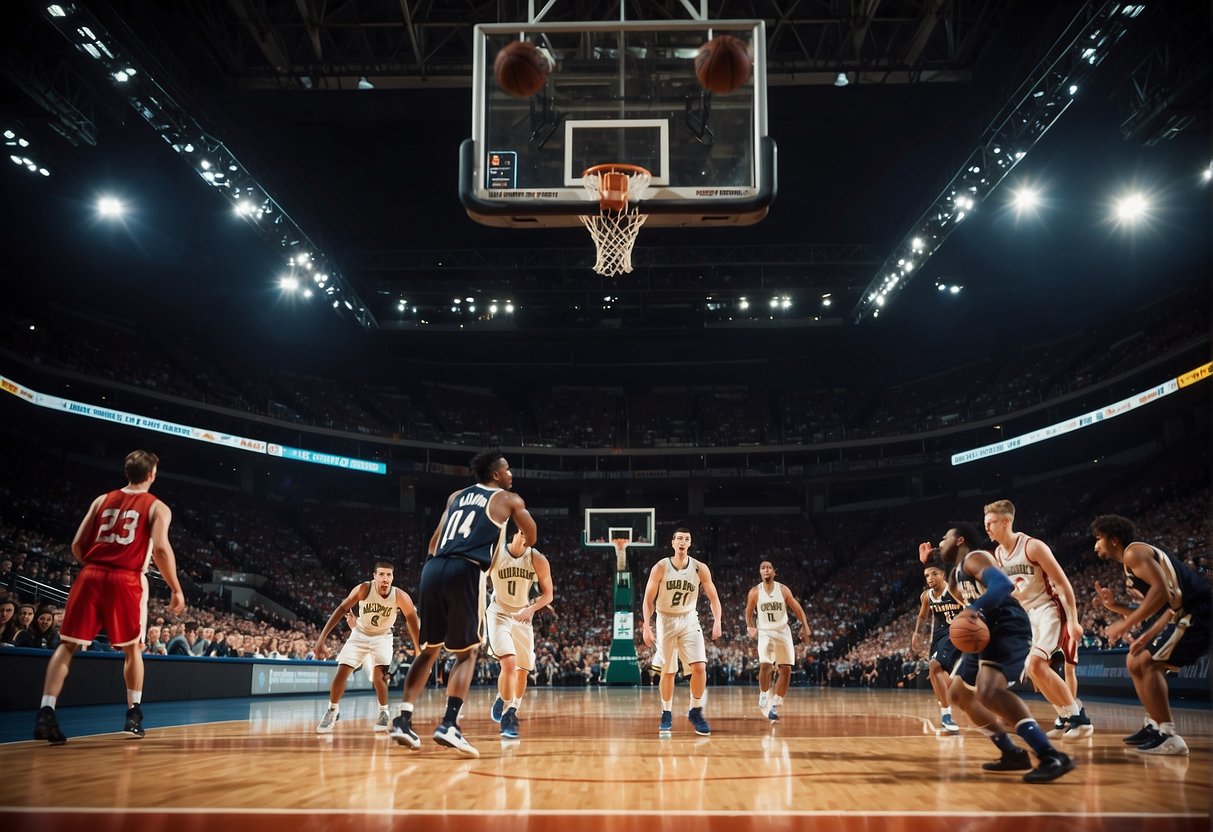Uncover the secrets of advanced basketball metrics through my in-depth analysis: understanding OWS in basketball. Delve into this sophisticated stat and its impact on evaluating player performance.
What is OWS in Basketball?
Offensive Win Shares (OWS) are a way to measure an individual basketball player’s impact on their team’s wins, based on offensive performance. Dean Oliver, a prominent basketball statistician, has contributed significantly to developing this metric, which essentially helps you understand a player’s contribution to the team’s success.
OWS is part of the broader concept of Win Shares, a statistic that also includes Defensive Win Shares (DWS), together encompassing a player’s overall contribution. While DWS focuses on a player’s defensive abilities, OWS looks at their ability to produce wins through scoring, assists, and other offensive actions.
In the NBA, calculating OWS involves a series of complex statistical analyses. It uses individual player statistics and team performance to estimate the number of wins a player has been responsible for on offense during a season. A higher OWS indicates a player has been more productive and valuable to their team on the offensive end.
Offensive Win Shares inherently relate to a player’s offensive rating, which calculates the points they produce per 100 possessions. By combining a player’s offensive rating with the team’s efficiency, OWS offers a quantifiable look at how a player’s offensive game translates to team victories.
Here’s a quick glimpse of how OWS is relevant:
- Understanding Player Value: OWS can help you compare the offensive value of players in the league.
- Fantasy Basketball: For fantasy basketball enthusiasts, OWS is a crucial stat for picking the right players.
- Team Management: NBA teams might use OWS to assess offensive strategies and player contracts.
Calculation of OWS

- Offensive Possessions: Every time a team has the ball and attempts to score, it’s called an offensive possession.
- Points Produced: A player’s contributions in points help gauge their effectiveness on offense.
- Offensive Rating (ORtg): An estimate of points produced per 100 offensive possessions.
Calculating OWS is a multi-step process. Begin by determining the player’s points produced and offensive possessions. With these values, calculate the player’s Offensive Rating using the following formula:
ORtg = (Points Produced / Offensive Possessions) x 100
To calculate the actual OWS, consider the player’s Offensive Rating, the league average, and adjust for team pace. It’s worth noting that the player’s OWS can only be as high as the team’s overall offensive performance, meaning their team’s output directly influences a player’s OWS.
Historical Context

When you dive into basketball statistics, you may come across the term ‘OWS’ or Offensive Win Shares. This concept, interestingly, has its roots in a different sport: baseball. It was first developed by Bill James, a baseball historian and statistician, who aimed to quantify a player’s contribution to their team’s wins.
In the world of the NBA, this statistic has been pivotal in evaluating the offensive prowess of players. In the records, legends like Kareem Abdul-Jabbar and Michael Jordan have impressive numbers, signaling their significant impact on their team’s success. Kareem Abdul-Jabbar stands out with his career Offensive Win Shares, reflecting his efficiency and longevity in the league.
Dean Oliver, an influential figure in developing advanced basketball statistics, further refined the concept of win shares. He tailored the idea to suit better basketball dynamics, a shift from its baseball origins. Oliver’s work has allowed you to appreciate the contributions of both scorers and facilitators like Oscar Robertson, whose overall game played a big role in his team’s victories.
The integration of Win Shares into basketball analytics provides a numerical value to help assess and compare players across different eras, offering context beyond traditional stats like points per game.
- Top NBA Players by Career Offensive Win Shares:
- Kareem Abdul-Jabbar
- Michael Jordan
- Oscar Robertson
OWS and Player Evaluation

Comparative Metrics
When comparing individual players in the NBA, OWS serves as a focal point but is most telling when paired with other metrics. Win Shares per 48 minutes (WS/48) offers insight into a player’s efficiency relative to playing time, accounting for the minutes they actively contribute during a game. Both metrics are particularly significant when evaluating players within the context of a season or over the scope of their careers.
In addition to OWS and WS/48, shooting efficiency is key. Effective Field Goal Percentage (eFG%) adjusts for the fact that three-point field goals are worth more than two-point shots, while True Shooting Percentage (TS%) also considers the value of free throws. Combined with OWS, these shooting metrics form a multidimensional view of an offensive contribution.
Significance in Player Contracts
Evaluating player contracts requires a deep dive into various performance metrics. OWS, quantifiable measure of how a player’s offensive skill translates to wins, becomes a cornerstone of contract discussions. As players age, maintaining high OWS can aid in securing more lucrative deals, as it indicates sustained offensive performance.
The NBA teams (TM) use such metrics to make informed decisions during trades and signings, allowing them to invest appropriately in talent that has demonstrated a clear ability to drive team success. Metrics like OWS become even more crucial when signing players who may not boast eye-catching traditional stats but whose presence on the floor unequivocally leads to more wins.
Controversies and Limitations

When you explore the concept of Offensive Win Shares (OWS) in basketball, you’ll find it’s a metric that tries to quantify an individual player’s contribution to their team’s offensive success. However, debates arise regarding its ability to capture a player’s impact on the game fully.
- Scope of Metric: OWS does a great job at assessing contributions based on statistical data but may overlook the less tangible aspects like leadership and morale-boosting that a strong player provides.
- Defensive Contributions: Defensive Win Shares (DWS) attempt to measure defensive prowess, but they can’t always account for strategic nuances that don’t appear in the box score.
Team Dynamics: Basketball is a team sport, and sometimes the OWS system can miss the mark on how a player’s offense benefits the team. For instance, a player might space the floor or set effective screens that lead to others scoring.
Given these considerations, you should take the information provided by databases like Stathead with a grain of salt. Although the data from such sources is fascinating and often valuable, remember that no one metric can define a player’s entire value to a team.
- Inaccuracies: Stats may differ across various platforms, including those managed by Sports Reference LLC. Always compare and contrast their findings with actual game footage for better insight.
Game Evolution: The NBA game is constantly evolving, and the metrics must adapt. The strategies that led to wins a decade ago may no longer apply, potentially skewing OWS and DWS calculations for different eras.
Legal and Intellectual Property

When you think of basketball, the high-flying dunks and buzzer-beaters might come to mind, but the game has a significant legal side involving intellectual property (IP) rights.
Logos on jerseys, shoes, and merchandise are not just designs but trademarks that legally protect the brand’s identity. So when you buy that jersey with your favorite team’s logo, you buy into a piece of carefully guarded IP.
The copyright aspect comes into play with the unique expressions of ideas, such as the games broadcast or how a league presents its information. For example, if a website like Sportslogos.net provides a detailed view of a team’s logo history, they must be mindful of the copyright laws protecting those images.
Regarding property, think of it as owning a house. With property in basketball, we’re talking about intellectual property—owning the rights to something non-physical like a logo. Now, if someone wants to use that logo, say for selling merchandise or promoting a service, they’d need authorization or a license from the owner. This is why you see official merchandise tagged as ‘licensed.’
Sports Reference LLC manages a wealth of data and statistics that fans and professionals use. Imagine creating content or a product that uses these statistics; you’d need to ensure you have the proper permissions to use their proprietary data.
- Trademark: Legally protecting logos and brands.
- Copyright: Protects the expression of ideas, from game broadcasts to statistical presentations.
- Property: In this context, it’s about owning rights to intellectual assets.
- License/Authorization: Required to legally use another’s IP, like sports data or team logos.
Utilization in Other Sports

Major League Baseball (MLB), for instance, uses a similar concept called Win Shares, a creation by sabermetrician Bill James that’s tabled to quantify the number of wins contributed by individual players. Metrics like WAR (Wins Above Replacement) also offer insight into a player’s overall value to a team.
In the National Hockey League (NHL), while there isn’t an equivalent Win Shares statistic, analytics have made strides with alternative metrics that encapsulate a player’s offensive contributions, such as Points Shares or Corsi and Fenwick ratings for puck possession.
League of Legends (LoL), an entirely different gaming arena, deploys sophisticated stats to evaluate player performance. Statistics like Gold Per Minute (GPM) or Damage Per Minute (DPM) are crucial metrics for gamers and teams looking to optimize their strategies.
It’s important to note that these metrics, while helpful, are only as powerful as their interpretation and application. Professional sports often partner with official stats partners like Nielsen’s Gracenote, providing comprehensive insights and bringing clarity to the jumble of numbers. As a fan, your appreciation for the nuances of the game will deepen as you become acquainted with these unique but equally significant statistics.
FAQ
What is the meaning of OWS in basketball?
OWS stands for “Offensive Win Shares” in basketball. It is a statistic that estimates the number of wins contributed by a player solely due to his offensive performance.
What is the OWS stat in the NBA?
In the NBA, OWS refers to Offensive Win Shares, which is a metric used to quantify a player’s offensive contribution to his team’s success. It measures the number of wins a player has contributed to his team’s total wins solely through offensive performance.
What do the abbreviations mean in basketball?
In basketball, abbreviations are often used to represent various statistics, metrics, or concepts related to the game. Common abbreviations include:OWS: Offensive Win Shares
DWS: Defensive Win Shares
PER: Player Efficiency Rating
PPG: Points Per Game
RPG: Rebounds Per Game
APG: Assists Per Game
FG%: Field Goal Percentage
FT%: Free Throw Percentage
TO: Turnovers
STL: Steals
BLK: Blocks
FGA: Field Goals Attempted
FTA: Free Throws Attempted
and many more. These abbreviations are widely used in statistical analysis, player evaluations, and discussions about basketball.
If you enjoyed reading about the topic: What is OWS in Basketball, leave a comment and stay updated on Pinterest for more exciting basketball news.
Leave me a comment and make sure to also check out How to Meet NBA Players Before Game.





